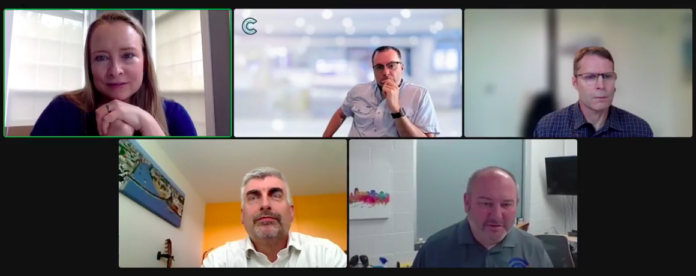The enabling ecosystem for LTE private cellular networks has matured significantly, but there’s still quite a ways to go when it comes to private 5G. And the network, as one participant put it, “is only one piece of the puzzle.” Spectrum availability, end-user device availability and overall flexibility also play in to whether cellular networks can accomplish the operational and financial objectives that enterprises are considering.
In a Private Networks Forum session, Stephane Daeuble, head of marketing for enterprise solutions at Nokia, said that the company has seen the state of the ecosystem improve significantly since it began deploying private networks in 2011. “Now, we have a lot of ecosystem players in pretty much al the segments we address,” he said, with a range of companies having validated LTE tech, providing planning tools and a solid variety of devices. 5G, however, is not yet as developed, particularly when it comes to integration of specific industrial features.
In some sense, private networks are both demonstrably providing real-world benefits, but also still finding their footing. Among the development factors discussed by the session participants:
-Establishing a baseline network framework that can then be customized for vertical-specific needs. Rasmus Hellberg, senior director of product management for Qualcomm Technologies described it this way: “You need a baseline — that we think is multi-vendor — that you can customize and program so you can set up certain use cases,” he explained. “But then, to really scale this and then meet the customer demand, you need to work from this network baseline, to work with specific system or challenges … for that vertical, then tweak the RAN and add the use cases and the programming for these use cases.” That, he added, is where Open RAN implementations may become particularly useful.
“Let’s be frank, I think a lot of these companies that are actually looking at building on these ecosystems and doing customization are doing so because they do have those unique requirements that aren’t being met by what is currently out there today,” said Cambridge Consultants VP of Wireless and Digital Services Jacob Reeb. “I think that drives part of it. The other part is that organizations want to own their own data, their own destiny, and potentially see a revenue opportunity. There’s a lot at stake for companies to look at this.”
Daeuble pointed to the importance of experience in putting together basic networks that are then customized, offering the example of mining. Once you’ve done 10 or 20 mines, he said “you realize you will always need the same ecosystem players”—and that they’re different for open-pit mines versus deep mines. Nokia, he went on to say, has put together “segment blueprints” for various verticals so that rather than customizing 15-20% of the solution, it’s only 2-3% that needs to be tweaked for a particular customers’ needs.
–End-user devices are a potential hiccup. The Murray City School District has been operating a CBRS network for several years, including launching a Fixed Wireless Access service to provide connectivity during the course of the global Covid-19 pandemic. Jason Eyre, technology department coordinator for the district, said that the network core and radios worked well together, but devices have been a stumbling block. “What we are finding is that the end-user devices, if you don’t find a vendor that’s completely open and unlocked with their chipsets, that you’ll find devices that you might buy somewhere and expect them to work, and they don’t,” he said. “And I think that’s where the industry is getting better, and we’ve definitely seen improvements over the past three years — but I think that’s a place where the industry can do better.”
-Figuring out Total Cost of Ownership. It’s still a tricky thing to do an apples-to-apples comparison between Wi-Fi and cellular, for businesses to figure out which one they should go with for their specific needs. Daeuble said that Nokia has some basic planning tools (with simple versions available online) that can help with estimates of a rough number of cells based on which frequency is being used—and that generally, looking at a TCO over 5-7 years, cellular has a comparable cost to Wi-Fi such that “the cost is no longer a barrier.”
It’s one thing to build a network, Reeb pointed out, and another one to fully understand the end nodes and their relationship to and impact on the operations of that network: How things fluctuate over time and how that affects design, capacity and ability to scale over time. One of the observations that Cambridge Consultants has made over time, he said, is that “a lot of organizations get themselves in trouble because they make a really large assumption at the very beginning of what they’re going to do which isn’t based on what is the best option, but as far as what is the lowest-cost option that we can do.”
He recommends that companies looking into private wireless engage experts not only for design but for advisory services to understand the technology choices available to them. “Really, what this comes down to, is that when you’re doing this—and it’s the same across any industry—you’re looking at trying to either build efficiencies or you’re trying to build a new revenue stream. If you keep that in mind and build it up from there, that’s where you can end up helping … your organization grow.”

